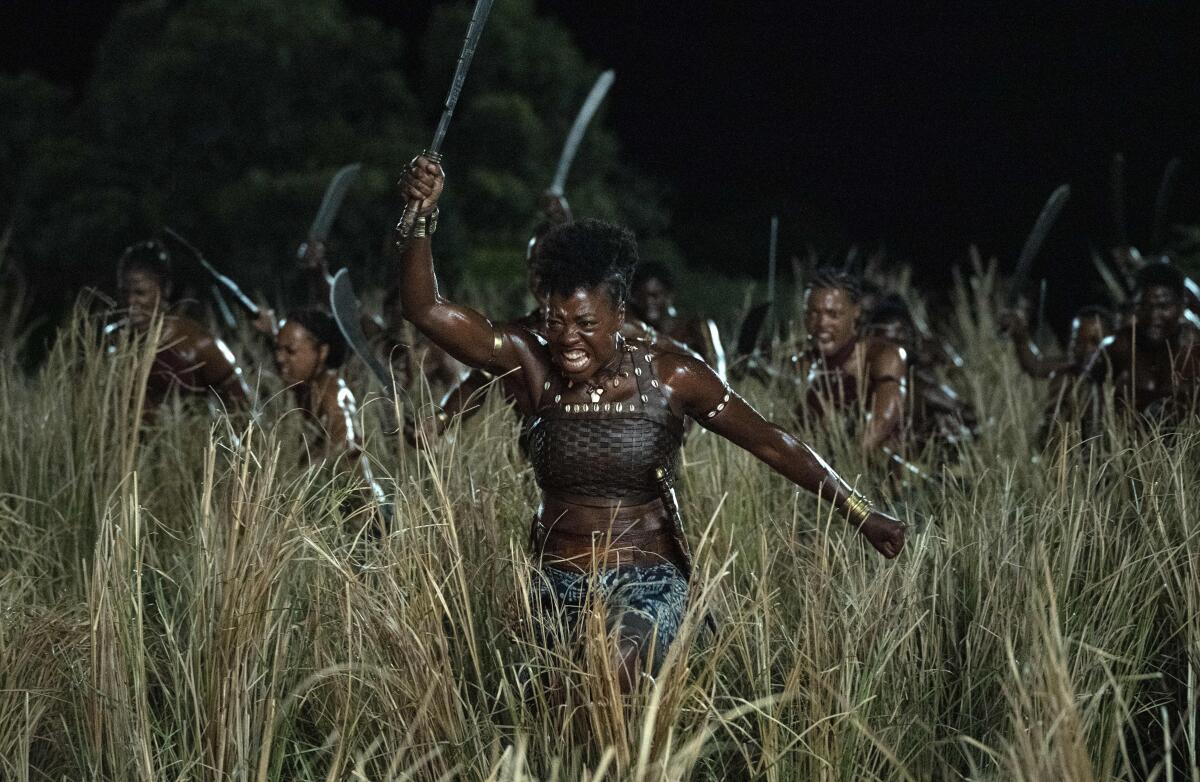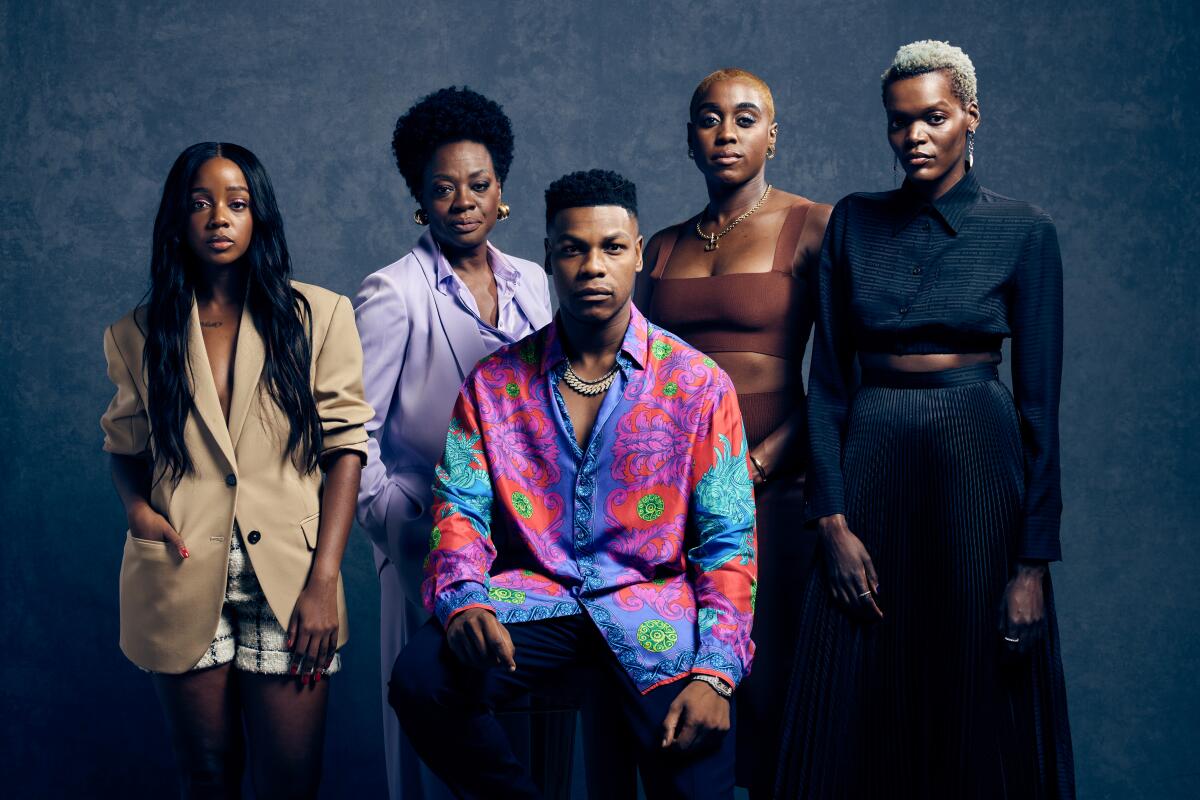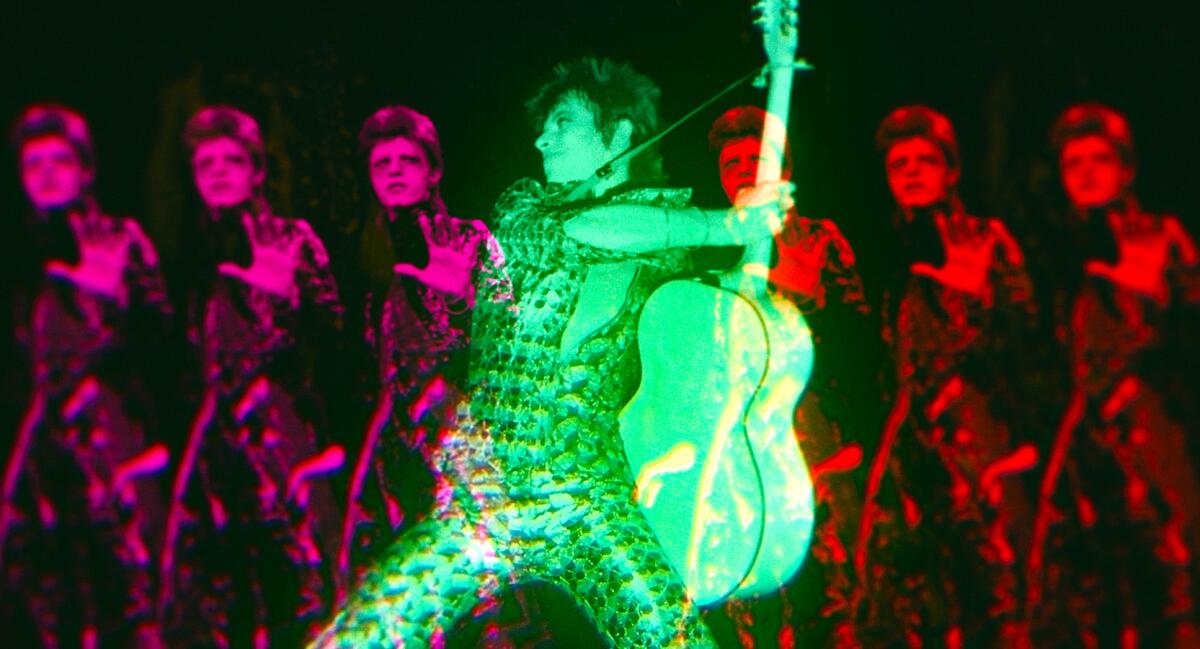‘The Woman King’ breathes new life into the action epic

Hello! I’m Mark Olsen. Welcome to another edition of your regular field guide to a world of Only Good Movies.
Only good movies
Get the Indie Focus newsletter, Mark Olsen's weekly guide to the world of cinema.
You may occasionally receive promotional content from the Los Angeles Times.
Jean-Luc Godard = cinema. The French filmmaker Jean-Luc Godard died this week at the age of 91. From his first feature film, 1960’s “Breathless,” to his last, 2018’s “The Image Book,” Godard pushed and reinvented the form and language of moving images, demanding of himself and audiences reconsideration of what cinema can be, formally and thematically.
As Justin Chang put it in an appreciation, “From the moment he burst onto the world cinema stage, Godard operated with both a cool, insouciant defiance of cinema’s entrenched rules and traditions and a refusal to unpack his meanings for easy consumption. … But to overemphasize the challenge of Godard — quite apart from ignoring the fact that difficulty can be, in itself, something quite pleasurable — is to risk understating the sheer beauty and, at times, the tenderness of his work.”
Here’s a quick primer on six films currently streaming as a place to start viewing Godard’s work.
An evening with Sacheen Littlefeather. The Academy Museum presents “An Evening With Sacheen Littlefeather” on Saturday night as part of a tribute to the actress and activist best known for the speech she made on behalf of Marlon Brando turning down his Oscar for “The Godfather” in 1973. The evening will include an official apology from the academy for the way Littlefeather was treated following that event. Tickets are sold out, but it will be available to livestream.
Directed by Wayne Wang. The UCLA Film and Television Archive and the American Cinematheque are partnering for a six-night tribute to pioneering Chinese American filmmaker Wayne Wang, who rose from small independent films to making big-budget studio releases. The series opens tonight with his debut, “Chan Is Missing,” on a double bill with “Slam Dance,” starring Tom Hulce. Other events include a double feature of his Paul Auster collaborations “Smoke” and “Blue in the Face,” plus “The Joy Luck Club” and more.
Wang is scheduled to be at all the screenings, and I will be moderating a conversation with the filmmaker on Sept. 25, between 35-millimeter screenings of 2002’s “Maid in Manhattan,” starring Jennifer Lopez, and 2006’s “Last Holiday,” starring Queen Latifah.
Enjoying this newsletter? Consider subscribing to the Los Angeles Times
Your support helps us deliver the news that matters most. Become a subscriber.
‘The Woman King’
Directed by Gina Prince-Bythewood from a screenplay credited to Dana Stevens, “The Woman King” is a historical action epic set among the female warriors of the African kingdom of Dahomey in the 1800s. Gen. Nanisca (Viola Davis) leads her cadre of fighters, including characters played by Thuso Mbedu, Lashana Lynch and Sheila Atim, under the rule of King Ghezo (John Boyega), as they ward off threats from neighboring rivals and encroaching colonialists alike. The movie is now in theaters.
For The Times, Justin Chang compared the film to action epics “Braveheart,” “Gladiator” and “The Last of the Mohicans,” writing, “If ‘The Woman King’ doesn’t always match the visceral intensity of those pictures — Prince-Bythewood, a skillful director of action, keeps the carnage to a PG-13 minimum — it nonetheless rises to the challenge of using an old-fashioned template to deliver a flood tide of exhilarating new images. To watch the Agojie warriors storm into battle, armed with swords and spears and led by Nanisca’s mighty ululating battle cry, is to encounter much more than the standard Hollywood vision of resistance in action.”
Having already written about the making of the film for the fall preview issue, Sonaiya Kelley recently spoke to the cast. As Davis said of the film’s importance, “It is a movie that really fully gives us our agency and autonomy in terms of storytelling. We are at the center of the narrative: dark-skinned, Black women warriors who are fully realized human beings. It gave us a chance to operate in a genre that [we’ve always wanted to be a part of but that] has predominantly been designated to white males. What it’s going to prove is that Black women can lead the box office and we can translate to a global audience.”
For the New York Times, Manohla Dargis wrote, “The action scenes are visceral, and more or less rooted in the laws of physics. … [Prince-Bythewood] puts you right on the ground so that you can watch these women fly. They do just that, not with superhero capes and fairy-tale enchantments, but with swords, javelins, twirling ropes and an occasional gun — as well as long, razored fingernails that scoop out enemy eyes, and thighs that crack men like walnuts. The women are their own greatest weapons, and among everything else it addresses, ‘The Woman King’ is about strong, dynamic Black women, their souls, minds and bodies.”
For Andscape, Soraya Nadia McDonald wrote, “Part of the beauty and strength of ‘The Woman King’ is that it has no interest in acknowledging the sticky lies of men like [Joseph] Conrad or author Ernest Hemingway, even to contradict them. Stevens and Prince-Bythewood and cinematographer Polly Morgan simply invest their energies in rendering the world of the Dahomey. Varied and intricate adornments of hair, makeup, clothing, and weaponry — as researched and brought to life by costume designer Gersha Phillips and a team of art directors led by Christophe Dalberg — fill every inch of the screen. In many ways, ‘Black Panther’ walked so ‘The Woman King’ could run. Even the visual effects are an improvement, blending seamlessly into the broader visual language of the film in the way ‘Black Panther’s’ Underground Railroad fight between T’Challa and Killmonger did not.”
For the Hollywood Reporter, Lovia Gyarkye wrote about the film’s world premiere, noting, “By the end of the opening sequence, a kinetic stretch during which blades slice flesh and fists collide with faces, it was clear that ‘The Woman King’ would be greeted by a generous reception. Energetic performances and technical precision come together to glorious effect in Prince-Bythewood’s rousing action film. It’s a lush, prime piece of entertainment in many respects. But as a product of Hollywood, working in the American cinematic lexicon, ‘The Woman King,’ with all its good intentions, nonetheless falls into the expected traps of melodrama and obfuscated history.”

Enjoying this newsletter? Consider subscribing to the Los Angeles Times
Your support helps us deliver the news that matters most. Become a subscriber.
‘Pearl’
Directed by Ti West, who co-wrote the script with star Mia Goth, the new “Pearl” is a prequel to the film they made together earlier this year, “X.” The character of Pearl, here a young woman almost six decades earlier, desperately wants to get away from her family farm to seek fame and fortune as a dancer. When circumstances force her down a different path, she snaps. The movie is now in theaters.
For The Times, Robert Abele wrote, “‘Pearl’ rarely justifies itself as a franchised standalone built on the early psychosis of its bloodthirsty, unstable ingenue when the wrinkled version in ‘X’ was tantalizingly freaky enough, and still made its points about the subjugation and exploitation of female sexuality across the generations. … Late in the film, Pearl delivers a teary confessional monologue that West serves up in one long close-up on Goth. Whether it’s a horrormeister’s bid for dramatic heft or a grand gesture to a talented leading lady, it’s more stunty than revelatory. It is, however, jokily complemented soon after by a similarly protracted hold on Goth’s frozen, creepy smile that’s infinitely more in tune with the half-mad/half-funny vibe that is ‘Pearl’ at its most entertaining.”
Jen Yamato spoke to West and Goth for a story publishing soon about how they came to make “X” and “Pearl” back to back, utilizing the same sets. As West said, “I had made a movie years ago called ‘The Sacrament,’ where we built a whole community and populated with extras for four weeks and shot a movie. And then the day you wrap, you just tear it all down and it’s very strange to just go, ‘All of that’s just gone now.’ I felt like, ‘Well, this is a unique time. We have all this stuff. What if we just stayed and made two movies — and what could that movie be?’ … So I asked Mia if she would be willing to stay longer if we were to pull this off, and she said yes.”
For the New York Times, A.O. Scott wrote, “The bloodshed is at least as grisly as the slaughter in ‘X,’ but ‘Pearl’ occupies a different corner of the slasher-movie universe. It isn’t especially suspenseful — the identity of the killer is never in doubt, and her victims don’t elicit much sympathy — but it has a strange, hallucinatory intensity. … Goth might remind you at times of Judy Garland in youth, of Shelley Duvall in the ’70s, or of a demonically possessed Raggedy Ann doll, but she has her own fearless and forthright intensity. West wants you to see that Pearl, a monster in the making, is also a heroine for the ages. Goth will make you believe it. Or else.”
For IndieWire, Kate Erbland wrote, “If ‘X’ is West’s love letter to ’70s-era exploitation films and indie porn, ‘Pearl’ is an unholy ode to Technicolor fairy tales and the corrosive power of Hollywood, even in its earliest incarnation. Set in 1918 — toward the end of World War I and smack in the middle of the Spanish flu epidemic that infected one-third of the global population — ‘Pearl’ attempts to fill in the blanks of Pearl’s backstory, a compelling enough idea that’s soon at the mercy of a rickety screenplay that’s both beholden to ‘X’ and determined to be its own thing.”

‘Moonage Daydream’
Directed by Brett Morgen, “Moonage Daydream” is a collage-style documentary drawn from the filmmaker’s unprecedented access to late musician and actor David Bowie’s personal archives, drawing from decades of concert footage, interviews, unreleased recordings, home movies and the like. The film is in theaters now, including Imax.
For The Times, Carlos Aguilar wrote, “In combining performances of the same song recorded years apart, ‘Moonage Daydream,’ also the name of one of Bowie’s early releases, glides across time and space positioning the icon as an entity that remained just as captivating throughout his mortal existence. … Wielding chaos into cinema — rather than creating an accumulation of factoids and anecdotes told by those who knew the performer — Morgen manifests a sensorial invocation of Bowie’s spirit, suited to delight acolytes and nonbelievers alike, for a tribute worthy of his unclassifiable genius.”
For the New York Times, A.O. Scott wrote, “[Bowie] is not so much the subject of the film as its animating spirit. … [Morgen] subordinates the dry facts of history to the mysteries of personality. ‘Moonage Daydream’ is interested in what it felt like to be David Bowie, and also, as a corollary, what it felt like, especially in the 1970s and ’80s, to be interested in him. Context and evaluation — the sources and influences of his music; its relation to what was happening in the wider world — are left to the viewer to supply or infer. The work, and the artist’s presence, are paramount.”

Only good movies
Get the Indie Focus newsletter, Mark Olsen's weekly guide to the world of cinema.
You may occasionally receive promotional content from the Los Angeles Times.




